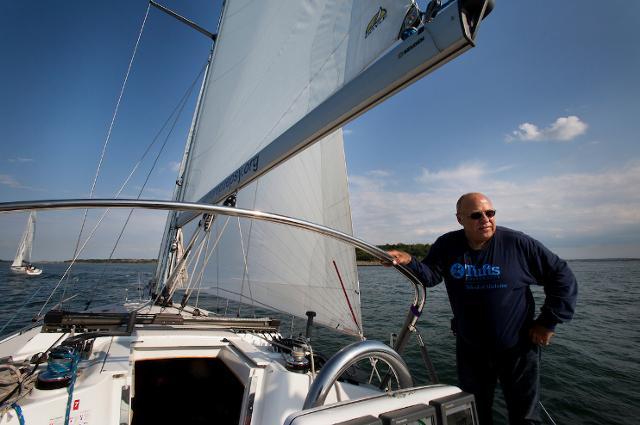-
About
- Departments & Offices
-
Academics
- Public Health
- Biomedical Sciences
- Physician Assistant
- Special Master’s (MBS)
-
Admissions & Financial Aid
- Tuition & Fees
-
Student Experience
-
- Student Resources by Program
- Academic & Student Support
- Wellness & Wellbeing
- Student Life
- Events & Traditions
-
-
Research
- Research Labs & Centers
- Tufts University-Tufts Medicine Research Enterprise
-
Local & Global Engagement
- Global Health Programs
- Community Engagement
Around the World with Epilepsy
Phil Haydon was just fifteen years old when he suffered a severe brain injury that resulted in post-traumatic epilepsy. Today he’s the Chair of Tufts School of Medicine’s Department of Neuroscience, and in November of 2021 he plans to set sail from Boston
Phil Haydon was just fifteen years old in 1972 when he suffered a severe brain injury while biking home on the last day of the school year—a brick hurled by a classmate struck Haydon in the forehead, knocking him across the street.
Bleeding heavily, Haydon pedaled back to school and was whisked away in an ambulance to the hospital, where he started having seizures within the hour. Doctors removed part of his fractured skull, eventually replacing it with a metal plate. Haydon spent the entire summer recuperating, and it took another year to get the post-traumatic epilepsy under control with medication.
“High school was a struggle after that,” Haydon remembered recently in his office at the School of Medicine, where he is the Annetta and Gustav Grisard Professor of Neuroscience and chair of the neuroscience department. “I had trouble concentrating. My schoolwork was not the best.”
Still, he later earned a bachelor’s degree in physiology at the University of Leeds in 1979 and found his calling in the lab during senior year. “It was logical thinking and practical work, and that’s where I really caught fire in terms of what I wanted to do,” Haydon said. He went on to earn a Ph.D. in physiology from the University of Leeds and complete postdoc training at the University of Iowa. He gravitated to neuroscience—“there was a certain degree of being able to relate to it,” Haydon said—and landed at Tufts School of Medicine in 2008.
Today, Haydon has been seizure-free and the epilepsy pharmacologically controlled for over forty years. He is considered a leader in the study of neuroglial interactions, having discovered in 1994 that the central nervous system’s glial cells respond to chemicals, and in doing so, release other chemicals that can activate neurons.
Haydon’s lab has published papers showing how glial cells change during epilepsy and how perturbing them in certain ways limits the number of seizures an animal will have. “One of the questions now is whether glia respond to a primary pathology elsewhere,” Haydon said, “or if they can be the primary pathology that leads to epilepsy, Alzheimer’s disease, and other brain disorders.”
Beyond his research, Haydon now wants to give back in another big way. In November 2021, he plans to set sail from Boston and circumnavigate the globe on a fifty-foot yacht flying a Tufts University School of Medicine flag to raise awareness and money for epilepsy research—about 50 million people worldwide have epilepsy. A percentage of all online and corporate donations to his Sail for Epilepsy nonprofit will go directly to the School of Medicine and one other partner, still to be determined. After he returns to Boston, he will sell his boat and equipment and give all proceeds to the partners.
Department:
Neuroscience
